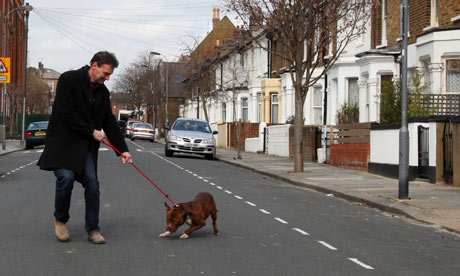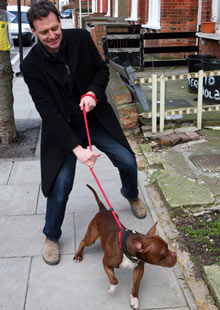My day as a dangerous-dog owner
Dangerous dogs are big news right now. But never mind all that stuff about microchips: what's it like to walk one? Tim Dowling finds out

Dowling tries to cross the road with Duddly. Photograph: Graham Turner
The idea of walking a dangerous dog did not immediately appeal to me as an assignment. I walk a non-dangerous dog every day, and even that is sort of a drag. To exchange it for a powerful, snarling beast would just add an additional, unwanted element of anxiety to the outing. As a pet owner, I already apologise enough.
When I say dangerous dog, of course, I don't mean dangerous at all. In fact, I'm not sure what I mean. Even the 1991 Dangerous Dogs Act doesn't have a clear idea: dogs outlawed under section 1 of the act don't have to be dangerous, just one of four proscribed breeds; one of those, the pit bull terrier, isn't really a breed, so "pit-bull types" and crossbreeds must be assessed as dangerous (without necessarily being dangerous, remember) on a case-by-case basis by a dog legislation officer. A dog that looks like a pit bull, but is in fact half-labrador and half-boxer, might well qualify.
Section 3 of the Act refers to dogs that are "dangerously out of control in a public place" and could technically apply to any breed – possibly not chihuahuas – but let us, for the sake of settling on a definition, simply change our terms. Let's speak instead of "status dogs", in reference to the large, heavily muscled, big-headed persuasion – usually Staffordshire bull terrier crosses of one sort or another – that are increasingly bred and reared for their threatening bearing, for use as a weapon, or even for dog-fighting. These are, after all, the dogs the government clearly had in mind when it unveiled legislation this week to make microchipping and third-party insurance compulsory; the type home secretary Alan Johnson said were bred "for the sole purpose of intimidating others". That's the sort. Where can I get my hands on one of those?
The Mayhew Animal Home in north London has a Staffy-bulldog cross called Duddly on its website who might fit the bill. Duddly looks deadly: he has the face of a nightclub bouncer and a body like a Victorian ottoman. They are willing to let me take him for a walk, although he will have to be recalled from his foster home.

One corridor of the Mayhew is decorated with pictures of celebrity supporters: Joanna Lumley, Jason Donovan, David Seaman. Chrissie Hynde and Brian Sewell both adopted dogs from the Mayhew; it may well be the only thing they have in common.
I've been to the Mayhew before; it's where I got my dog. It's also where I made my wife take a Staffy-cross bitch I found tied to the railings of the park gates last year – abandoned, pregnant, heavily scarred and mildly insane. Although the Mayhew has space for just 35 dogs, it is contracted to take in all the strays rounded up by Brent council, and around 25 dogs pass through their doors every month, most commonly Staffy crosses. Because the breed now has a reputation as a dangerous dog, Staffies are harder to re-home. The wrong type of people seek them out; the right type don't want them. Their reputation, according to the Mayhew's CEO Caroline Yates, is undeserved. "Twenty years ago they were top of the list for ideal family dogs," she says.
Duddly hasn't arrived yet, so Yates shows me some of the other dogs they have in at the moment, including a pair of Rhodesian Ridgebacks whose owner couldn't cope. They're enormous; a child could ride one like a horse. There has been such a glut of backstreet breeding of Staffies recently, says Yates, that they've begun to lose their status as status dogs. People are seeking out bigger, less familiar breeds, and the unwanted ones are starting to show up in the Mayhew.
Yates welcomes any strengthening of dog legislation, although she thinks the government's proposals come at the problem from the wrong angle. Compulsory microchipping, she says, is "good, but not much use on its own". The microchip identifies the original owner, but most of the strays they take in have been passed from hand to hand before they're abandoned. It's not preventative, and it's no deterrent. She favours licensing, and has little time for the objections of "responsible" dog owners. "Licensing and registration should be a recognition that you are a responsible dog owner," she says.
Finally, Duddly arrives. Unfortunately for my purposes, Duddly is not deadly. He may look the part, but in the flesh, Duddly is cuddly. He doesn't have any unresolved anger, or a killer instinct. He does suffer from separation anxiety, according to the Mayhew's Dan Stibbs, perhaps as a result of his abandonment. Duddly's worst trait is that he hates being left alone. When I bend down to pet him, he licks my face. His breath isn't bad for a dog, but I know that's not much of a compliment.

Which isn't to say that Duddly isn't a bit of a handful. Taking him for a spin round the block is like waterskiing behind a tethered shark. Even our overall route is a compromise between the direction he wants to go in and the one I do. It's alarming to be only nominally in control of something so big and powerful; it reminds me of a time when, in search of a van to move some furniture, I accidentally hired a lorry.
The streets of Harlesden are quiet at midday, but there is no question that Duddly, straining at his lead as I dig in my heels – he has amazing traction – constitutes an intimidating presence. People heading in our direction spontaneously cross the road as we approach. Passing cyclists give us a wide berth. It is empowering, I suppose, to be at the helm of something that alarms people so readily. Certainly my own personal safety was the last thing on my mind, although I couldn't say I had time to stop and enjoy the sense of security. I was too worried about what would happen if I let go of the lead.
"He's really very friendly," I say to one passerby who has chosen to walk down the middle of the road to avoid us. He looks unconvinced. If I were him, I would be too: although Duddly is gentle, sweet-natured and frankly, a little needy, he's also untrained and therefore unpredictable. When he stops in the middle of the pavement and his ears shoot up, my first thought is, "Oh my God, Duddly, what are you going to do?" It turns out he's going to sit down and refuse to move because he's frightened of the traffic cone across the street.
Training a dog like Duddly, who is already two years old, can be difficult. "If you don't put the work in by 16 weeks, it's really hard," says Stibbs. "You can do it, but it's a lot harder."
After a brief but exhausting tour of the local area, it's time to say goodbye to Duddly, whose abandonment the 1991 Dangerous Dogs Act – a piece of legislation almost no one has a good word to say about – did so little to prevent. "The law as it stands at the moment hasn't worked," says Yates. In addition to the proposed government reforms, she would like to see the Dangerous Dogs Act amended – with the contentious section 1 repealed – and the introduction of compulsory neutering for all breeds.
"There are too many dogs in this country," she says. "Full stop."

No comments:
Post a Comment